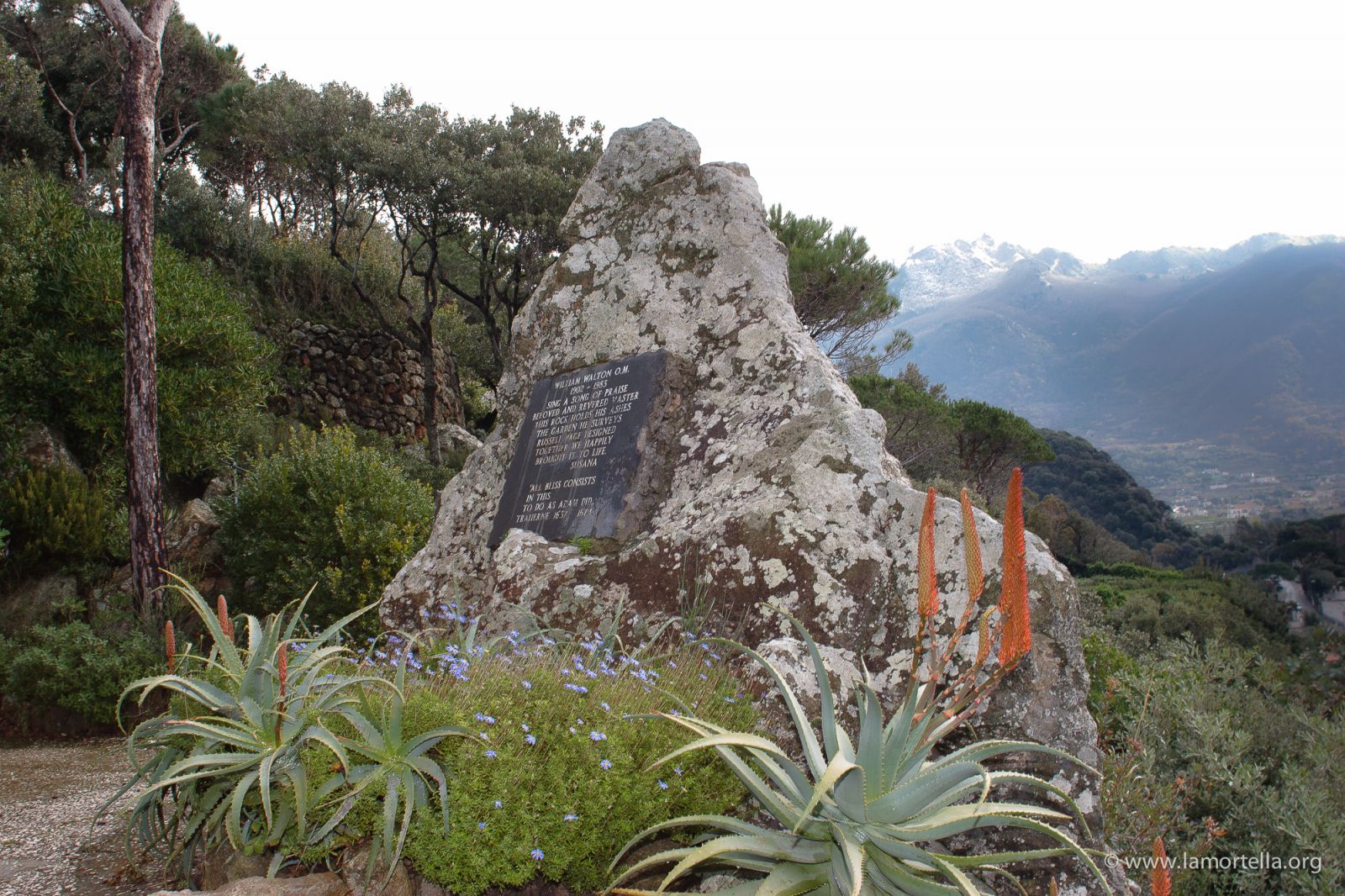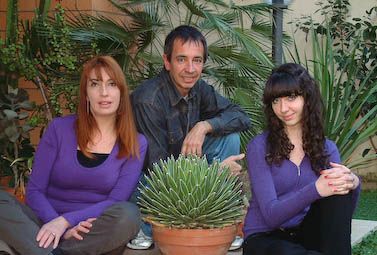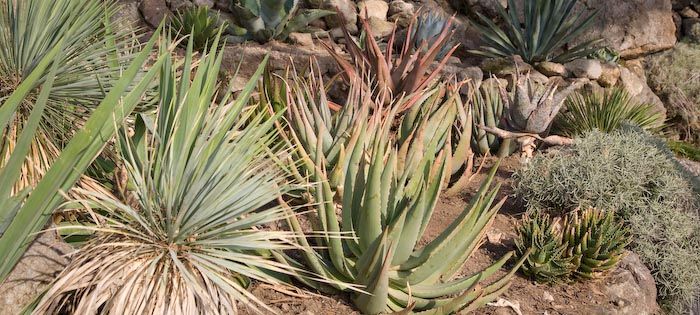Until last September 2008, the occurrence of Aloes in La Mortella Gardens was not particularly meaningful. Just like all gardens in the South, there were many clumps of Aloe arborescens growing on the slopes of the hill and self-propagating here and there. In the course of the years several varieties had been introduced by Lady Walton: Aloe vera, ferox, some A. marlothii, two plicatilis, a bainesii, some princeps, a couple of striata, a few gracilis, and some occasional purchase, such as the three A. polyphylla, religiously grown from micro-propagation plantlets. Altogether, had perhaps a dozen species that delighted us with their bright winter flowers.
Then one day, in September, we received an email in which Carlo Riccardi, an Aloe collector and expert from Lanuvio (Rome), told us that he was forced to find a new home for of his Aloe collection, (about 150 different species and varieties) assembled in more than 20 years of research and passion, as he had to leave the garden he was growing his plants in. Would La Mortella be interested in accepting the collection as a gift?
Of course we accepted with enthusiasm, assuring him that his plants would not only find here a wonderful setting to highlight their beauty, but would also receive constant care and attention, a future, public acknowledgement. And we told him he could come and visit any time he wanted, to check how they were faring. We agreed a date to organize the delicate operation of transplanting and move the collection. On October 9, 2008, all Aloes were lifted from the soil, temporarily potted or positioned in various containers, and loaded on a truck. The next day at dawn they were already crossing the bay on a ferry boat and arrived in the island; less then 24 hours after having been removed form their original position, they were resting in trenches or pots, with pumice and volcanic crushed stone to protect their roots.
And then we started planting them in the garden, and we are still doing it. It is a wonderful adventure, and La Mortella will be forever grateful to Carlo Riccardi and his wife Enrica. We know it must have been very hard to let go such a collection of plants, after so many years of love and cares. But their generous and altruistic decision, to donate the plants to our garden, will allow so many people to enjoy the result of their passion. They opened a new horizon to the many thousand of visitors that come to the garden, and gave their plants the best possible condition to survive in time, opening a new chapter in the story of the collection that we hope to develop in the future. Here is an article written by Carlo and Enrica about the collection, and how they came to donate it to us.

The Garden of Aloes
by Enrica e Carlo Maria Riccardi
These notes have no botanical ambition; you will not read that Aloes belong to the family Asphodelaceae or find a description of the plants, their shape, roots or seedheads; many authors, more knowledgeable than us, already wrote about this. We would like to tell you how we came to create a place where these plants could grow free and healthy, the way they do in their country of origin, so distant, fascinating, mysterious: Africa. “Aloe tricolor flore rubro” and “Aloe africana caulescens foliis glaucis caulem amplectentibus”. Thus were labelled the first Aloes ever introduced in Europe, in 1695. They came from the gardens of the Dutch East India Company in Cape Town, South Africa; today they are named, thanks to Linneus, “Aloe maculata” and “Aloe arborescens”. Actually, the history of Aloe dates back to much earlier times, thanks to its medical properties. References to this plant (probably A. vera) are to be found in Sumeric tables, and in Egyptian temples’ inscription. A papyrus scroll dating about 1550bC has a list of Aloe-based remedies that appears like a magic ritual formula. This is not the place to deal with this aspect, although interesting; going back to 1695, some time passed before botanical expeditions were carried out methodically, but by the end of 1800 (up to today) the African continent slowly unveiled its treasures. Baker, Schonland, Pole-Evans, Reynolds and more recently S. Carter and J. Lavranos, to name but a few, were involved in researching and describing Aloe and unknown succulents. As said before, we wanted to recreate the best possible growing condition to cultivate our Aloes. All those who are involved in growing succulents (or every plant, indeed) know how important it is to know the exact condition where a variety grows in the wild; such knowledge will allow the grower to grant it the climate and exposition most suited, be it dryish (A. striata, A suzannae) or moist (A.bellatula, A. haemantifolia). Aloes, tipically, grow everywhere in Africa, including the islands (A. aldabrensis from Seychelles, A. macra from Reunion island) and the arabic peninsula (A. tomentosa, A. fleurentinorum). They are found in the widest possible range of habitats, from Namibia desert (A. pillansii), to the Mediterranean climate of coastal South Africa (A. mitriformis), or tropical highlands (A tauri, A. zebrina grow at 1800 metres). Moreover there are species that grow on perfectly vertical cliffs (A. corallina, A. hardyi) , and other that in the winter are covered by snow a (A. polyphylla).
All considered, someone could have suggested to give up our plans, and stick to cultivating them in pots. However, we accepted the challenge: had it been easier, it wouldn’t have been so fascinating to plan a garden of Aloes. Actually, having grown them for more than ten years, we had a thorough experience and had exchanged information with other aloe lovers (specially friends from the Latium branch of the Adipa - Association for the cultivation of unusual plants). We knew that this genus of plants could thrive in our climate, wasn’t too fussy about soils, could even stand the cares and tortures that passionate growers like us lavish on our plants – what with experiments, trials, transplants. We had seen a wonderful A. maculata growing in a terrace way up North, in Turin; a gigantic A. vera thriving in a smallish pot, and a A. striatula in full bloom, outdoors in February, near Rome.
Clearly our passion for such a versatile genus, so rich in shapes and dimension, from giant A. excelsa and spiky A. ferox, to minimal A. bowiea, could not be confined to a bunch of pots on a balcony: it deserved to develop its potential outdoors, in a field. Fortunately my parents lived in the countryside near Rome, and they offered their garden. So we selected the spot, and installed a tunnel structure covered with a plastic film, with open sides. We did not need to prepare any special soil: the garden is in the Castelli Romani, a group of volcanic hills south of Rome with a very fertile soil, high in potash, with excellent porous grain and high air content. We added, for the sake of zeal, slow releasing fertilizer N:P:K=8:20:24, a multi-purpose insecticide in grains and we tilled the soil to a depth of 30 cm, and manually weeded the whole area. Now we finally had a place to grow our Aloes.
The following Spring we moved our pot-grown plants in their new garden. The bigger ones (A. ferox, A. littoralis) took more time to get accustomed to the new position and recover, probably because they were slower to rebuild an efficient root system. The weekly irrigations and the mild temperatures (rarely below 0°C in the winter, and hardly above 30°C in the summer; only once we experienced a -6°C in the winter, without major damages) helped starting the new garden. Already the first summer we were rewarded with the first blooms (A. jucunda, A krapoliana v. dumoulinii). In January, in spite of a long drought begun in November and the resulting shrunken look, the Aloes started to bloom in a sequence: the pink flowers of A. microstigma were followed by the delicate red flowers of A. pictifolia, then the typical red blooms of A. variegata, the pale pink, yellow shaded flowers of A. prinslooi, the fiercely orange spikes of A. ammophila). The invasive A. maculata (saponaria) produced two imposing flower stalks and begun to sucker. When we took to watering, in March, every day we found that a new plant was blooming: the garden was by then established, to our satisfaction.
All this was happening in 2003.
The whole process – the selection of the place, installation of a sheltering coverage, soil preparation, and then transplanting the plants - had been a fatiguing work, but we were rewarded by the results. After many years of dreaming about it, a whole garden space completely devoted to Aloes was finally born.Our satisfaction was improved by the positive reaction of the Aloes, that flourished, grew healthy and lush, and produced spectacular, multicolored blooms year round. In the following years, many plants suckered, others fruited and produced plenty of seeds; this allowed us to give pups and seeds to other collectors and aloe lovers. Thus we helped spreading the knowledge of this wonderful plant genus, a genus that is better known for it s medical virtues than its beauty and garden value. 
Unfortunately, like many dreams come true, we were woken up abruptly. In 2008 our situation changed and we were forced to accept the idea that the garden had to be moved in a different place.
For months we were completely absorbed by a range of proposals and suggestion, looking for a solution. All possibilities were carefully evaluated, pros and cons weighed, but none seemed to meet our requirements – often, something would happen at the last minute, to prevent a solution to be adopted.
At one point it looked like we were stall and had no ways out of the predicament we were; but then we understood that we had to change our attitude towards the future of our collection. We should not think about what we wanted for ourselves, we should select the best solution for the plants. From the moment we realized that the priority was the well-being of the plants, we decided to offer the collection to the Gardens La Mortella in Forio d’Ischia: the best place we could hope to find for our wonderful, fascinating plants. We would like to thank Lady Walton, creator of the garden, Alessandra Vinciguerra, garden director, and Fondazione William Walton e La Mortella, that manages the gardens, for the constant effort they put in the conservation and protection of all plants grown in this veritable “paradise garden”: they guarantee that our dream will survive.
AKNOWLEDGEMENTS
Thanks to Priscilla, to Gaetano Palisano for his advice and all the rest, to Jole and Giampietro who edited the text, to the members of Cactus & Co. of Latium branch, who bear with our “vegetables”: aloe, gasteria, haworthia.
A New Aloe Corner at La Mortella – a Brief History of the New Accessions
by Alan Butler
In early May 2011, we were delighted to hear that La Mortella Gardens had accepted our offer of over 100 plants, mostly aloes but also a few agaves and related genera. The plants have been with us for around 20 years in some cases, and to give the history of each one would probably require writing a small book. Sufficient to say that Brookside Nursery has been in existence for 30 years and there are many stories to be told. I suppose thousands of plants have moved through our hands over the years and often turn up, now unrecognisably large! However the nursery has always had its collection of mother plants from which we produce offsets or seed. Part of this collection is a very large selection of aloes, haworthias and gasterias. These plants, like many others as a result of recent DNA research, have moved around the plant families. When Liliaceae was divided up, these plants were put in Aloaceae, which seemed logical, then Asphodelaceae which is understandable, but latest DNA research tells us that they all belong to Xanthorrhoeaceae being nested within this more ancient family evolutionarily-speaking.
For various reasons it was not practical to plant directly into the ground in the greenhouse where we keep our plants, so they remained in pots and some of the larger aloes and agaves were becoming difficult to handle. Although our current location in Nettuno is certainly warmer than England, winters can be cold and it is unwise to plant rare material outside, so we were given to thinking about a new location for them, which is where La Mortella comes into the picture.
So what about the actual plants? As I have said, each one has its story. Some were grown by us from seed, some were purchased from other nurseries as young plants or given to us by collectors, and some have been produced from material collected over the years in Arabia and Africa. Where possible every plant carries a label with collection number and habitat information. Several were acquired as young seedlings from one of the largest aloe collections in Europe, belonging to Brian Miller and located in south-west Scotland! So the plant collection is a world in itself.
In the space available I cannot write about every plant so I have selected a few that are perhaps the most spectacular:
Aloe striata: This large plant with thick, fleshy glaucous leaves comes from Southern Africa. The inflorescence is large with many branches and orange-coloured flowers (fig. 1 shows the developing buds)
Aloe secundiflora: Another large plant from Kenya collected by Alan Butler south-east of Nairobi on the old Mombassa road growing in grassland. The inflorescence is branching with red flowers carried in a secund orientation on the stem (all pointing one way) (fig. 2)
Aloe dhofarensis: A very beautiful plant that comes from Dhofar Province in Southern Oman (fig. 3). The leaves are covered with a heavy powdering of white, although the actual leaf underneath will turn dark brown, almost black, in bright sun. In Oman they grow in very arid places exposed to full sun and are sometimes rather ugly as a result, until the glossy red flowers appear in the summer monsoon season. The plant is surprisingly resistant to cold temperatures despite its warm habitat, but needs some protection from rain.
Aloe sp. aff. dowei: Another beautiful Arabian species. This plant was grown from seed collected in 1986 in Yemen, south-west of Taiz. The parent plant had hairy yellow flowers (fig. 4) but this plant flowered only recently in Italy and has hairy red flowers (fig, 5). Unfortunately it produced no seed, but maybe in the open air it will find the right pollinator.
Aloe conifera: A large aloe from Madagascar with leaves that turn purple shades in sun, and inflorescence cone like in bud (fig. 6) developing into a capitate inflorescence with large pendant yellow flowers. (fig. 7)
Aloe vacillans: A large aloe from Arabia growing in Yemen and Saudi Arabia. The plant was collected by an English botanist, Sheila Collenette, who has written two books on the flora of Saudi Arabia, and who donated the plant to Brookside as it was too big for her window-sill. Like many Arabian aloes, it can have yellow or red flowers (fig. 8). This one has red flowers.
I am looking forward to visiting the gardens in the future and I hope to see that the plants have flourished. At any rate they now have a permanent home in a mild climate and their travelling days are over!




